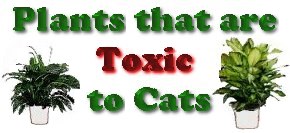

 |
Below is a list
of common
houseplants that can be harmful or fatal depending on the quantity
swallowed. Also, remember that cats who chew plants are exposed to any
chemical pesticides or fertilizers that may have been applied directly
to the plants or through the soil.
You can prevent your cat from chewing on plants by misting the leaves then sprinkling them with cayenne pepper. You might also want to consider planting a container of grass (regular grass, not the drug) for your cat. If your cats are digging in your pots, go to your local hobby/craft store and buy a few pieces of plastic needlepoint canvas. Trim it to the shape of the pot, cut a slit in it and then a hole in the center for the plant. Rest it on top of the soil and your cat will be unable to dig. Note that any plant that looks like a variation of grass is likely going to be considered food to a cat, so it's best to keep them in hanging pots well out of reach. Symptoms of poisoning will range from seizures and foaming at the mouth to vomiting and coma. Immediate medical attention as soon as you see the cat has eaten a toxic substance (don't wait for symptoms to appear) is necessary. Take the cat to your local veterinarian immediately. The ASPCA National Animal Poison Control Center is a 24-hour emergency service with phones manned by licensed veterinarians and toxicologists (these are not free calls; have your credit card handy): You can call 24
hours a day
from anywhere in the U.S. 1-888-426-4435 By the way, if
you provide a small container of grass (oat grass or regular grass),
your cat might leave your potted plants alone. |
|||
Note: Only the Dracaena sanderiana (aka Ribbon Dracaena, Lucky Bamboo, or Ribbon Plant) is toxic. True bamboo is not toxic. |
||||
|
|
||||
Related Links:
|
||||
|
|